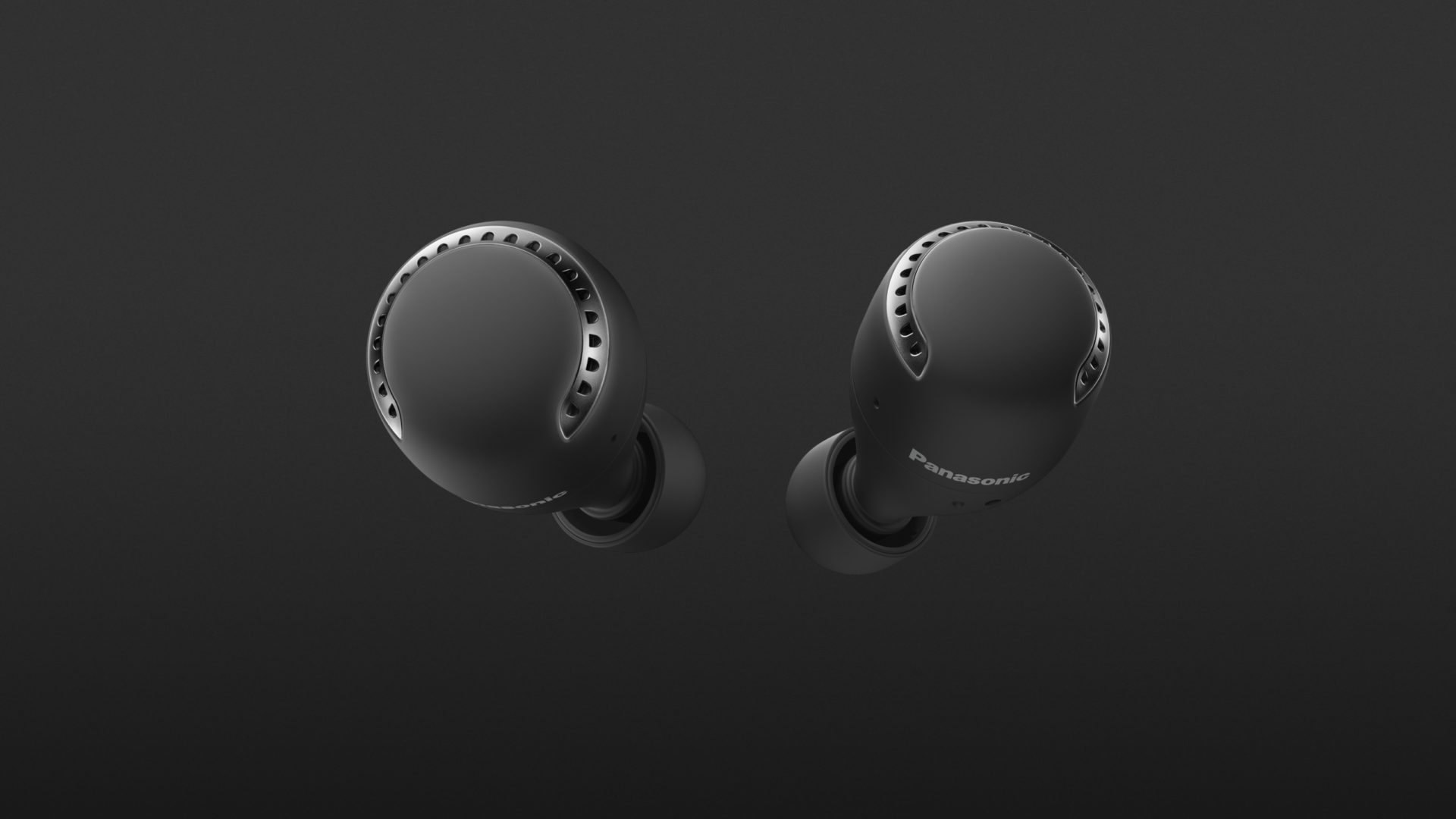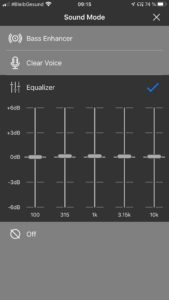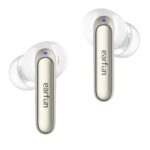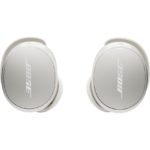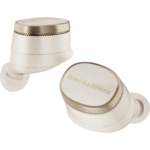With the RZ-S500W, the manufacturer can justifiably celebrate a successful debut in the field of “True Wireless In-ears with Noise Cancelling”. Market-leading noise cancelling or not – simply put, they work very well and show the more expensive competition that headphones under 180 Euros can also make it to the top of the list. And if you like listening to electronic and modern music genres you will be pleased, because the RZ-S500W’s bass provides cosy warmth and puts in considerable energy. The mid and high frequencies are not as present as the low frequency range, but this can be adjusted using the equalizer if necessary. After all, the RZ-S500W aim to accompany you on all your travels and guarantee you long, fatigue-free listening pleasure – and they certainly achieve that!
- very good noise cancelling for this price range
- modern, bass accentuated sound
With the RZ-S500W, Panasonic enters into the market for True Wireless in-ears with noise cancelling, and they make the bold claim that their debut product in this field has market-leading noise cancellation built in. And at a price of under 180 Euros – we are certainly listening very closely.
The package
The IPX4 splash-proof RZ-S500W in black or white comes with five pairs of silicone earpieces in sizes XS, S, M, L and XL and a 50-centimetre USB-A to USB-C cable. All this is accompanied by various information leaflets in different languages. It’s not much, but it’s enough, and the choice of sizes of the ear moulds can only be praised.
Wearing comfort
After finding the right ear moulds, you are rewarded with very good passive isolation as well as a comfortable fit. With seven grams per earpiece, the RZ-S500W are among the lightest examples of their kind, and this means they are not annoying to wear. Due to their design, however, they protrude from the ears to a certain extent so hat-wearers might have complaints about pressure. A positive aspect is the perfect workmanship of these earphones which also applies to the transport case (45 grams), but this doesn’t look quite as expensive as the earphones due to the plastic material used.
Running times
The lithium polymer batteries (85 mAh) of these earphones run between 6 and 6.5 hours depending on the operating modes, and they can also be operated individually in mono mode. With the charging case – which is able to charge the tiny device up to two times – the total time is up to 19.5 hours. In practice, these run times weren’t entirely accurate and were each about 30 minutes below the length of time claimed, but this is probably due to the higher level and the temperature. Nevertheless, this is a decent figure. Thanks to the quick-charging function, you can get about 70 minutes of listening time after only fifteen minutes of power supply. The battery in the charging case (lithium polymer 800 mAh) can be charged via USB-C connection.
Operation
The initial pairing of the Panasonic RZ-S500W takes place when the headphone(s) is/are removed from the case. If you want to connect the already paired in-ears to another device (multipoint is not supported), you first have to disconnect the original player and then press one of the two touch surfaces for seven seconds within three seconds after removing it from the case. These in-ears remember the last ten devices that they have already been paired with, so if an eleventh device is added, the oldest connection is deleted.
In our test with different Android and iOS devices we achieved extremely stable ranges: In the open air, the first drop-outs could only be heard after about 36 metres, but inside an apartment, we did not hear any drop-outs even across a whole floor.
If a wireless connection is established, simply tap the left side to control the Play/Stop function. By tapping the left side quickly two or three times, the volume can be lowered or raised accordingly. Holding the left touch sensor for two seconds starts up your voice assistants (incl. ‘Alexa built in’), while the right-hand side allows title jumps back and forth by pressing two or three times. Pressing the right for two seconds switches between noise cancelling, transparency and normal mode. It is also possible to answer calls by tapping either side while ending the call requires a two-second press.
Control of the touch surfaces always worked perfectly, but with a delay of about one second, and the range of controls available directly on the headphones leaves hardly anything to be desired as all the important functions are covered by the RZ-S500W. Nevertheless, I would still like to have a touch lock, to avoid accidental triggering of functions while adjusting the earpieces.
App connection
With the free, somewhat old-fashioned looking app “Panasonic Audio Connect” for Android and iOS, there’s also the possibility to make some fine adjustments via Smartphone: This is the only place where noise-cancelling and transparency mode can be continuously adjusted, and under “Sound Mode” a five-band EQ as well as the sound presets “Bass Enhancer” and “Clear Voice” are available. Any changes to the EQ are saved, but multiple presets cannot be created. The most important settings in the app include prioritising sound quality (the AAC codec is used) or connectivity (codec is set to SBC) and after how many minutes an automatic shutdown should occur. Another useful feature is the find function: On a geo map, and/or by means of beeps, the headphones alert you to their whereabouts.
Noise cancelling and transparency mode
How does the noise suppression of the RZ-S500W, which according to the manufacturer is the market-leader in noise cancelling, work? In one word: Excellently! The combination of Feed Forward and Feedback Noise Cancelling (also called “Dual Hybrid Noise Cancelling”) as well as digital and analogue signal processing literally sends you into a quiet zone. This is done by microphones, which pick up and cancel noise from both the outside and inside, resulting in a much wider cancellation effect than would be achieved by simply placing microphones on the outside. Passing trucks no longer roar unpleasantly, the twittering of birds becomes much quieter and telephone calls taking place in the neighbouring room are hardly audible. The intensity of the noise cancelling, adjustable via the app, is very subtle. At the lowest level, a little more noise reaches the ear, but sometimes the differences are hardly noticeable.
The transparency mode (here “ambient noise”) also adjusts smoothly, but the differences are clearly audible. In general, this mode also works very well, even if it doesn’t come close to the naturalness of Apple AirPods Pro . Activation is also accompanied by increased background noise, but this is masked during playback of music.
Reverberation when walking, which occurs when headphones seal so tightly that the resulting pressure in your ear makes it possible for your to feel the your steps as a muffled reverberation, is not entirely suppressed by these in-ears, but neither it is particularly pronounced in this model.
Sound
The bass range of the dynamic 8mm drivers is very powerful yet remains amazingly defined. The sub-basses of modern music genres are perfectly reproduced by these headphones without splashing or depriving the other frequency ranges of air. And although I don’t generally favour headphones with exaggerated bass, these add a nice weight to the bass – this fits modern genres perfectly! In some songs you can hear how the artists/producers want the basses to be understood in context with the rest of the song.
Of course rock and pop songs also profit from this warmth, but it is noticeable that these in-ears could be a bit more lively in the mid range of acoustic songs: Classical songs lack radiance here, which I also missed in the high frequencies. But that’s why these headphones don’t sound bad and I’d only consider them less suitable for audiophile classical and jazz lovers as the appropriate instruments are not strikingly highlighted.
In the highs, this continues, and it must be noted that a tamed high range is far less strenuous on your hearing, so that even after hours of use they are not so tiring to use. Nevertheless, details can still be heard well and the distribution in the stereo image is clearly represented. But even with this model, the stereo image could be more detailed – a shortcoming that in-ear headphones often have due to their design.
If you switch off the noise cancelling and transparency mode, it changes the sound and these in-ears sound less bass-heavy, but the midrange and the trebles assert themselves better.
The speech quality left me with mixed feelings: Our caller understood us moderately to well on the phone, but the noise suppression of the microphones caused words to be cut off now and then in windy conditions.
Technical specifications
- Ear couplingIn-ear
- Typeclosed
- Transducer principledynamic
- Frequency response (headphones)20 - 20.000 Hz
- Impedance32 ohms
- Weight without cable7g each, case 41 g
- Cable length50 cm
What's in the box
- 5 pairs of earmoulds in XS, S, M, L, XL
- USB-C charging cable
- Charging case
Special features
- available in black and white >li>BT codecs: AAC, SBC
- BT version: 5.0
- BT profiles: A2DP, AVRCP, HSP, HFP






